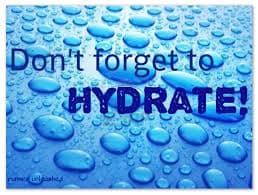I used to love training in the heat. I lived in CO for 21 years and moved to Georgia in April 2016 so have experience in both dry and humid climates
If you have ever spectated or raced in an endurance event such at Ironman, you have seen many athletes in the med tent getting intravenous administration of a dextrose or saline solution to rehydrate and can help facilitate recovery. My one experience in the med tent happened in 2014 after Ironman Boulder. Although I did not feel heat exhausted after crossing the finish line, I felt nauseated and choose not to drink the bottled water given to me. About 90 minutes after I finished I knew something was not right and went to medical. I was shocked how dehydrated I was with a blood pressure of 60/40. It took 2 liters of fluid while lying in the tent followed by a trip to the hospital for 2 more liters to feel better and get my bloop pressure up to 90/60.
Training in hot and humid climates can be challenging, but with proper precautions and awareness of the signs of heat-related illnesses, you can stay healthy and perform at your best. Here are some key points to consider:
- Differentiate between heat exhaustion and heat stroke: Heat exhaustion is characterized by symptoms such as headache, fatigue, chills, nuausea, and confusion. It can usually be treated by stopping exercise, getting out of the heat, and rehydrating with fluids. Heat stroke, on the other hand, is a more serious condition that requires immediate medical attention. It is characterized by confusion, central nervous system dysfunction, and a body temperature over 104 degrees. If you or someone else experiences these symptoms, it’s important to seek emergency medical services.
- Stay hydrated: Hydration is crucial when training in the heat. Drink plenty of fluids before, during, and after exercise. The American College of Sports Medicine recommends consuming approximately five to 10 ounces of fluid every 15 minutes during workouts. Clear urine is a good indicator of adequate hydration levels.
- Wear appropriate clothing: Choose breathable clothing that wicks away moisture and aids in the evaporation process to keep you cool. Wearing a sun visor and sunglasses can also provide additional protection from the sun’s rays.
- Adjust training times: If possible, schedule your workouts during cooler times of the day, such as early morning or evening, to avoid the hottest hours. If the temperature is dangerously high, consider opting for an indoor workout or adjusting the intensity of your training to accommodate the heat.
- Pace yourself: Recognize that your body will be working harder in hot conditions, so adjust your pace accordingly. Listen to your body and take it easier than usual, as you may not be able to achieve your normal speed or effort level. Treat it as a moderate or easy day to prevent overexertion.
- Ensure proper rest and nutrition: Get enough rest and ensure you’re well-fed before training in the heat. Fatigue and hunger can exacerbate the effects of heat, so prioritize getting sufficient sleep and fueling your body adequately.
Remember, training in the heat requires extra caution and attention to your body’s signals. Be proactive in preventing heat-related illnesses by staying hydrated, adjusting your training approach, and seeking medical attention if necessary. By following these guidelines, you can continue to train effectively and enjoy your racing experiences in hot climates.
American Heart Association Staying Hydrated
Planning for the Heat in Kona,
Running in Hot weather Endurance Hour YouTube Channel.
Have more questions about heat or race day nutrition or hydration? Contact t2coachwendy@gmail.com.
Join Our Awesome Newsletter!
When you sign up for our free newsletter, you’ll receive a weekly publication jam-packed with Health, Fitness and Performance Advice PLUS you'll receive a special 33% discount code to our Training Plans on Training Peaks and other exclusive sponsor deals! What are you waiting for!? Add your email below and click Subscribe.

